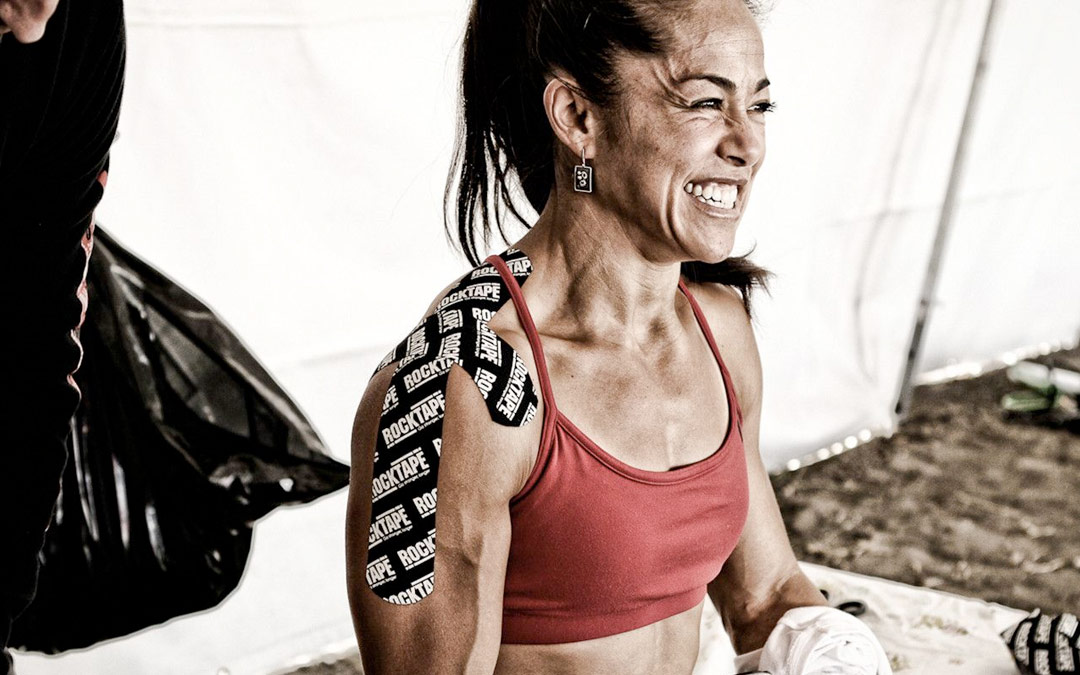Don’t let aches and pains be an excuse. Tape up and get to work.
Because of the way RockTape stimulates nerve receptors in your skin and deeper tissues, it also can downregulate pain and improve both mobility and stability. With plenty of upsides, here are picks for the top five best CrossFit applications for RockTape:
Hands
Every CrossFit athlete knows how easy it is to beat up your hands while training. RockTape can effectively protect your palms and those calluses you’ve worked so hard on, especially when your training involves lots of metal spinning in your hands. (Think kipping pull-ups and kettlebell snatches, for example.) This application requires some scissors work, but once you’ve done it a couple of times, you’ll feel like a pro!
Adhere two strips down the palms of your hands and a strip around your wrist to lock them down. All your calluses should be covered and your palms virtually encased in armor. RockTape takes chalk nicely — and unlike most gloves — the layers of tape are so thin you’ll barely notice there’s anything between you and the work you’re doing.
Shoulders
Just about everything in CrossFit requires both shoulder mobility and stability. Whether you’re upside down on your hands, pressing overhead, or doing pull-ups or Olympic lifts, the demand on your shoulders is exceptional. We recommend taping in a way that basically surrounds the deltoid muscle while hitting the upper traps and AC joint (the point of your shoulder). Make sure you use enough tape on one of the strips to extend back onto your shoulder blade. Most of the mobility and stability of your shoulder comes from your shoulder blade, so don’t neglect it!
Lower Back and Spine
As much demand as CrossFit places on your shoulders, your lower back and trunk are just as important. Your “core” is the connector between the top and bottom halves of your body, and as your heart rate goes up, your core has to be mobile, stable and continue to breathe all at the same time.
Lower-back injuries typically happen as you get tired. You lose stability as your breathing rate climbs, and RockTape can help buy some of that precious stability back. When taping your lower back, bend forward to stretch the area and run two strips of tape from your sacroiliac joints up to your lower rib cage — one on each side of the spine. If you’re having lower-back pain, you also can use the standard or Big Daddy tape over the area that hurts. If it’s your midback or neck that tends to be a problem area for you, follow the same instructions but move the application up to where you need it most.
Knees
With all the squatting variations that happen in CrossFit, you’re sure to get cranky knees from time to time. The KneeCaps and Assassins knee sleeves provide great protection and support for your knees, but if you’re looking for a little less bulk, then RockTape has you covered (literally).
Just like with the shoulder, the basic knee-taping framework involves three pieces of tape. The two longer strips surround your kneecap and extend up into the thighs to encourage muscle activation in the quads. The third strip goes right over your patellar tendon and the sides and front of the joint line, where most knee aches and pains occur.
Elbows
While golf hasn’t quite made it into CrossFit boxes and competitions yet, CrossFit athletes are predisposed to or medial epicondylitis. Cleans, overhead pressing movements, forward pressing movements, and pull-ups and rope climbs can be hard on the elbows, especially if your technique isn’t dialed in.
This simple tape application covers your wrist flexors and the inside of your elbow. When you apply the shorter piece, just make sure to angle it enough so that it avoids the crease of your elbow. This is a sensitive area for most people, and keeping tape away from those few inches of skin is always a good idea.
